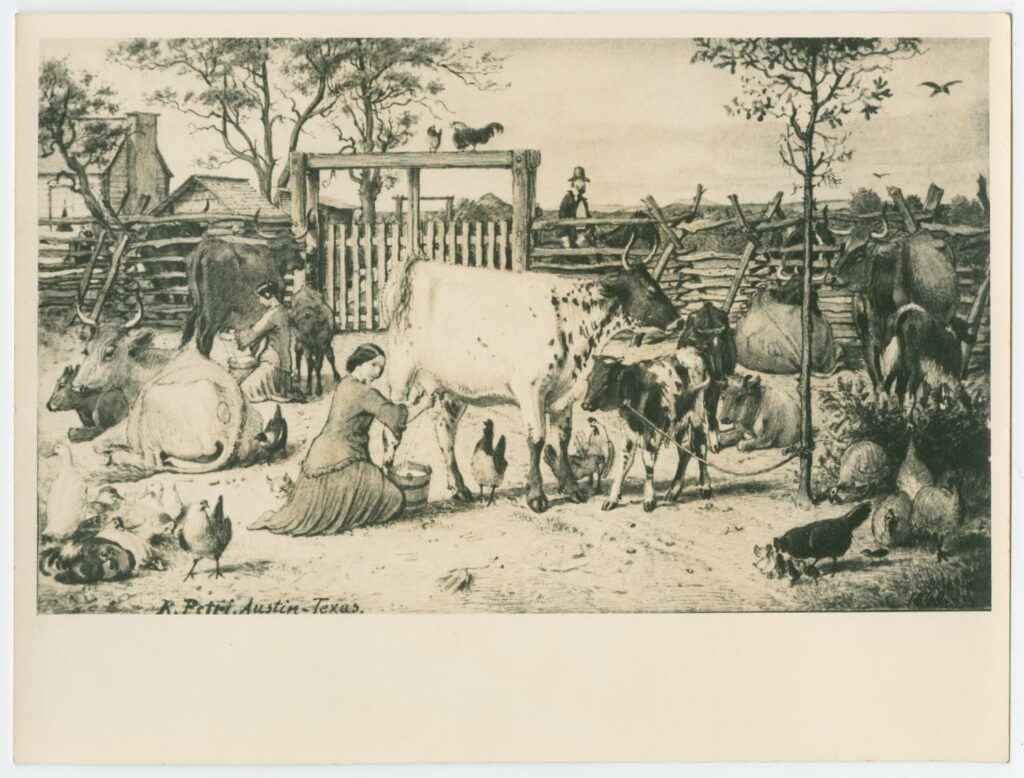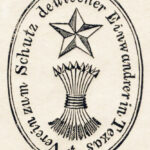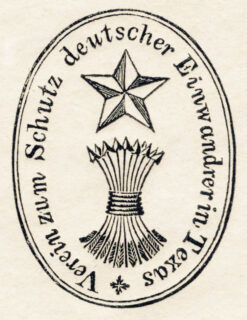Texas Germans’ Migration and Knowledge
A Miniseries on Nineteenth-Century Germans’ Migration to Texas and Knowledge Transfers
With contributions by Jana Weiss, Abigail Escobedo and Simon Herbert, Jacob Johnson and Taylor Mullins, Rodolfo Alvarez and Aubrey Hernandez, Aiden Maliskas and Mark McShaneModern America is a land of rich diversity, especially regarding food. Americans with strong ethnic identity take pride in their ethnic cuisine. The diversity of U.S. food is reflected both in the household and the expansive restaurant industry. However, early Texas German settlers entered a world very different from our own. These settlers found themselves on the frontier, far from the domesticated urban centers of the East Coast and Europe. As Texas Germans adapted to their new home, they had to change their eating habits, creating new foods and adjusting old recipes, ultimately, also impacting modern American foodways. These factors inspired our research into how Texas German settlers from the nineteenth century adapted to the foodways of their new homeland. Migrant knowledge was key as they used their prior knowledge and created new knowledge to create Texas German foodways. Eventually, Texas Germans adapted their dietary and culinary practices to the limitations of the Texas frontier while attempting to maintain their German traditions whenever possible.
Our primary sources mostly come from The Golden Free Land: The Reminiscences and Letters of Women on an American Frontier, edited by Crystal Sasse Ragsdale.1 Ida Kapp was a refugee of the 1848 revolution. Her letters exemplify the immediate reaction to the transition from Germany to Texas. Auguste Wiegreffe was born in 1843 in Colorado County after her family immigrated to the U.S. in 1838. Her excerpt covers the conditions in New Braunfels during her childhood. Louise Romberg Fuchs immigrated to Texas in 1847 at the age of seven and wrote her memoir detailing her early life at age 84. Mathilda Doebbler Gruen Wagner’s family immigrated to Texas in 1851; she was born in 1856. Her memoirs depict the struggles of growing up on the frontier. The fourth source is the memoir of Emma Murck Altgelt, who was born in 1833 and immigrated to Texas at age 20. Her excerpt covers her first eight years in Texas during the lead-up to the Civil War. As some of these sources are from memoirs written during the twentieth century, slightly removed from when the authors lived through what they later described, they are not completely reliable, but they are nonetheless valuable. While we may not be able to fully believe specific individual stories, the context surrounding them and the overall life experiences reinforce the findings of previous scholarship on this topic. Lastly, we looked at a letter by Friedrich Ernst, the father of German migration to Texas in the 1830s, which details the ease of growing livestock in Texas.2

Cherishing and Criticizing Food Availabilities
One source of satisfaction for German migrants was increased (and regular) meat consumption. In Germany, meat was quite expensive. However, while people were generally poorer in the U.S., they ate much more meat.4 The answer to this paradox lay in land availability. Germany was overpopulated, and agricultural production was at capacity. Fewer meat calories can be produced per acre compared to potatoes and grains, so Germany lacked the space to raise enough meat to satisfy the demand. Richter claims that in 1816, the average German only ate 36 pounds of meat a year. In contrast, Texas’s vast open plains allowed widespread ranching to meet demand – a proverbial utopia for breeding livestock. Ernst, marveling, wrote of cows and calves being sold for ten dollars and ranchers herding several hundred heads of cattle. The average American ate 176 pounds of meat per year.5

Despite the mental image many have of cattle-ranching Texas cowboys, Texas Germans’ preferred meat was pork. Pigs are smaller and easier to raise than cattle. Wagner’s account testifies that while settlers originally hunted wild hogs for pork, they eventually tamed the hogs. Texas’s oak trees provided many acorns to fatten both wild and domesticated hogs. From these pigs, Texas Germans made smoked sausages.6
While the tasty wonders of Texas German sausages are known to most people nowadays, there is also a practical rationale for sausage smoking aside from the flavor. When combined with salting, smoking effectively preserves meat. Sausage smoking is an excellent example of migrant knowledge Texas Germans brought with them. In the pre-refrigeration era, food preservation was difficult, so these long-lasting smoked sausages served as an important food source.7
Outside of animal husbandry, hunting also served as a steady meat supply. The memoirs of Fuchs and Altgelt both attest to hunting as commonplace. Their families hunted venison, wild boar, turkey, and prairie chickens to add to their food supply.8 Hunting was more permissible in the U.S. than in Europe, where the nobility legally restricted hunting into the early modern era. Poaching still happened, with venison as the most appetizing target, but it was risky and not a consistently available supply of meat.9 The U.S., on the other hand, had no class-based legal restrictions on hunting.
Richter and Kamphoefner mention that meat consumption was one of the most common topics in family letters written to Germany.10 The letters called the U.S. a land of plenitude where anyone could eat meat all day every day. These letters provide insight into migrant knowledge of food availability in the U.S. and generated dietary expectations for those looking to migrate. One German migrant said he was inspired to immigrate as “[L]etters had arrived written by some person living in America setting forth in glowing terms the glories of that country, demonstrating itself [sic] in a special manner at a meal, such rich and bountiful dinners, meat three times a day and cakes and pies.”11 Although some scholars emphasize the exaggeration and questionable reliability of claims in such letters, it is clear that the writers ate more than their European counterparts.12
While more meat was available in the U.S., Texas Germans struggled to find their preferred potato. Germans were used to a potato-heavy diet. Germans ate potatoes not only for caloric density but also for taste. Yet, the U.S. did not have the Irish potatoes Germans were accustomed to.13 Rather, the sweet potato was the dominant variety since typical European varieties did not grow well in Texas. This bred frustration for some who felt sweet potatoes “resemble chestnuts very much, only one is not used to eating chestnuts in place of potatoes.”14 Texas Germans certainly loved the availability of food, but still missed some cherished foods and sought replacements.
One surprising replacement of the early Texas German diet was molasses instead of cane sugar. For early frontier settlers, molasses served as a sweet treat and as medicine (although the illness so cured is not mentioned). Producing molasses was a long, arduous process. It sometimes required a full day’s work and was hazardous, often resulting in injuries and burns. The effort they took making it shows that Texas Germans loved molasses as they proclaimed it was both delicious and healthy.15
Adjusting to Scarcities
Although Texas Germans had more access to food than their European counterparts, they also faced notable scarcities. Wheat and rye breads were a staple of the German diet, so adjusting their recipes to accessible flours made it difficult to retain the flavors they knew.16 Ida Kapp detailed her experiences in a letter home. Kapp explained that German migrants incorporated cornmeal into their bread recipes because wheat flour was expensive: “for a dollar you get 80 to 100 pounds of corn meal in comparison to 14 pounds of wheat flour.”17 The higher cost was due to Texas lacking the proper agricultural environment for mass wheat production. New York and Pennsylvania were the prime states for wheat flour production, and importing wheat flour from the East Coast was expensive.
Corn, by contrast, was simple to produce within Texas agriculture. Some German migrants produced their own cornmeal using a stump as a grist mill. While Anglos typically used mere cornmeal and water to make cornbread, Texas Germans often added a small portion of wheat flour to create a hybrid bread whose taste and texture were more familiar. Kapp disparaged “normal” cornbread as steinhart (hard as a rock) unless eaten hot.18 Clearly, Germans sometimes found it difficult to adjust to Texas foodways.
Kapp’s letter reveals the importance of familiar recipes for Texas Germans. They used their existing knowledge of traditional German breads to create a new Texas German bread. Despite being in a new country, they wanted a taste of home. This highlights the importance for migrants of maintaining aspects of their home culture while adapting to new environments. Similarly, butter was not consistently available, either, and Texas Germans craved butter with their bread. According to Kapp,
[t]he bread would taste so much better if we always had butter with it. Today we had butter and we ate three-fourths of a large loaf for supper. To me it tasted as good as any other bread... You hear it almost unanimously that one can get accustomed to corn bread.19
Other household goods that were common in Germany but rare in Texas included milk and fruit. Auguste Wiegreffe, an original settler in New Braunfels, mentioned the scarcity of these items and how having access to these was seen as “luxurious.” Not many German migrants could obtain these items as migration had been expensive.20

Relatedly, since Texas Germans could only bring a few items while traveling, they lacked cooking instruments like ovens and stoves upon arrival. Wiegreffe attested to this when she described German migrants arriving in New Braunfels and working together to create a proper town because they had little from the homeland. The first settlers would cook over a large fireplace or outdoors and use Dutch ovens (heavy, wide, shallow pots with well-fitting lids). Dutch ovens were common throughout the U.S. as their simple and versatile nature allowed for a wide range of uses. While German migrants may not have been familiar with the Dutch oven specifically, they were familiar with pots in general, so it was a simple adaptation. Because of the size of the community and lack of cooking supplies, they would spend all day making sourdough bread (with cornmeal) because they only had three skillets that could make one loaf at a time. Like Wiegreffe, Kapp discussed the (scarce) cooking utensils she used once in Texas: a pot, a pan, a cornbread pan, and a fire in the yard.21
Texas Germans had preferences when it came to preparing certain dishes. Apart from rejecting pure unaltered cornbread by mixing in portions of wheat flour, they also rejected the hasty food preparation methods Anglo settlers seemed to use. Anglos would cut a roast into pieces and fry them, while Texas Germans slow-cooked entire roasts at a time.22 With modern Texas barbecue’s emphasis on slowly smoking entire meat cuts, we can see that the German method expanded over time to Anglos.

Conclusion
Our research demonstrates that Texas Germans had to replace many of their favorite food traditions like buttered wheat/rye bread and Irish potatoes. However, they adjusted their recipes and enjoyed increased meat and molasses consumption as well as increased food security. German migrants based their new recipes on available items and pricing, adding new food groups to their traditional diet, and they found new ways to prepare their food with the resources they had, all while holding onto their cultural identity. Their pre-existing knowledge – that is, the knowledge they brought with them as migrants – was essential to their adaptation as they strove to create new, Texas German foodways. Although our sources recount personal experiences and contain certain biases of an educated class of women, we conclude that Texas Germans were resilient and willing to adapt their culinary customs to have a new life in Texas.

Rodolfo Alvarez is an incoming law student at the University of Texas at Austin. He is interested in studying cultural development and wrote his undergraduate thesis on Christianization of werewolves in medieval Ireland.

Aubrey Hernandez is an undergraduate student at the University of Texas at Austin. She is an Audiology major and is going into her senior year.
- Crystal Sasse Ragsdale, ed., The Golden Free Land: The Reminiscences and Letters of Women on an American Frontier (Austin, 1976), 40–47, 65–83, 87–111, 132–55, 156–88. ↩︎
- Reprinted in Detlef Dunt, Journey to Texas 1833, ed. James Kearney and Geir Bentzen (Austin, 2015), 30–35. ↩︎
- Martin Göttlich et al., “Traditional Breads from Germany,” in Traditional European Breads, ed. Marco Garcia-Vaquero et al. (Cham, 2023), 115–36; Linda Richter, “‘Could You Not Turn Your Back on This Hunger Country?’: Food in the Migration Process of German Emigrants,” 1816–1856,” Aspeers 5, no. 3 (2012): 19–26. On food availability and European restrictive hunting laws cf. Nikolaj Bichel and Adam Hart, “A History of Hunting and Hunting Perceptions,” in Trophy Hunting, 33–38 (Singapore, 2023); Walter Kamphoefner, Germans in America: A Concise History (Lanham, 2021), 137–64. ↩︎
- Richter, “‘Could You Not Turn Your Back,'” 32; Kamphoefner, Germans in America, 140. ↩︎
- Detlef Dunt, Journey to Texas, 30–35; Richter, “‘Could You Not Turn Your Back,'” 32. ↩︎
- “Mathilda Dobbler Guen Wagner” in Golden Free Land, ed. Ragsdale, 164. ↩︎
- Martin Marchello and Julie Garden-Robinson, “The Art and Practice of Sausage Making,” North Dakota State University, last modified October 2022. With the influence of German smoking, it is no surprise that Texas developed its smoked BBQ culture. Future research may further illustrate the connection between early German and Czech practices and modern ones. ↩︎
- “Louise Romberg Fuchs” and “Emma Murck Altgelt” in Golden Free Land, 67 and 164, resp. ↩︎
- Bichel and Hart, “History of Hunting,” 35–39. ↩︎
- Kamphoefner, Germans in America, 140; Richter, “‘Could You Not Turn Your Back,'” 31–32. ↩︎
- Cit. in Richter, “‘Could You Not Turn Your Back,'” 26. ↩︎
- Ibid., 30–33; Kamphoefner, Germans in America, 40–47. ↩︎
- Ragsdale, ed., Golden Free Land, xi. ↩︎
- “Ida Kapp,” in Golden Free Land, 106. ↩︎
- “Mathilda Doebbler Guen Wagner,” in Golden Free Land, 167, 180–18. Moreover, honey was also an important sweetener for Texas Germans as it does not naturally spoil. German immigrants were the first Texans to emphasize beekeeping (Thelma Burleson and Diana Kleiner, “Bee Industry,” Handbook of Texas Online, (published 1976/updated 1994). Our sources do not mention honey despite the heavy bee presence in the Hill Country. Further research on the prevalence of honey is necessary. ↩︎
- The use of different grains for making bread can completely change the bread’s profile. For example, rye bread has a stronger, earthier taste while wheat bread tends to be sweeter. Corn was not as common in Europe, which can explain why Texas Germans perceived cornmeal as foreign and preferred not to use it (Göttlich et al., “Traditional Breads”). ↩︎
- “Ida Kapp,” in Golden Free Land, 105. ↩︎
- Ibid., 106; Rudolph Leopold Biesele, “The First German Settlement in Texas,” Southwest Historical Quarterly 34, no. 4 (1931): 334–39. ↩︎
- “Ida Kapp,” in Golden Free Land, 106. ↩︎
- “Auguste Wiegreffe” in Golden Free Land, 46; Kamphoefner, Germans In America, 25–46. ↩︎
- “Auguste Wiegreffe” and “Ida Kapp,” both in Golden Free Land, 43 and 104, respectively. ↩︎
- “Ida Kapp,” in Golden Free Land, 98. ↩︎





